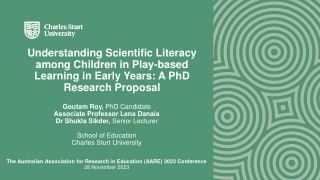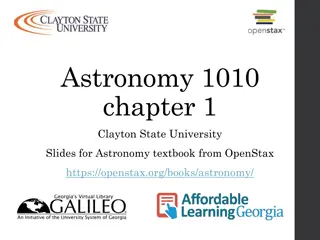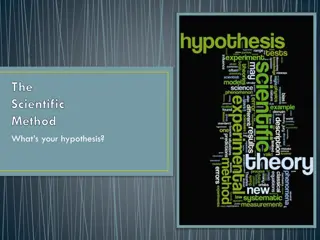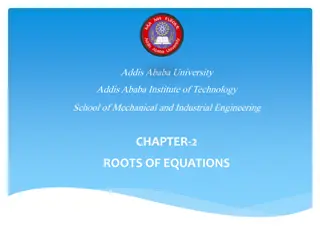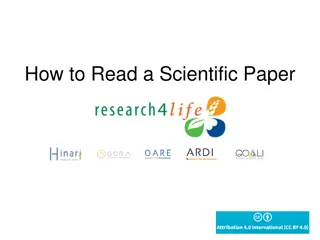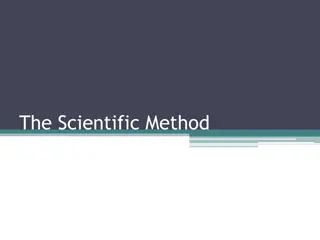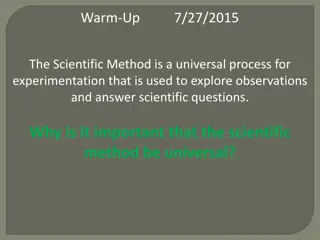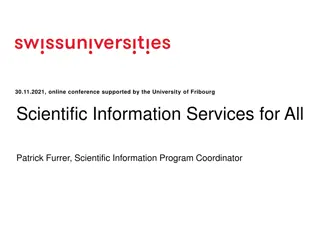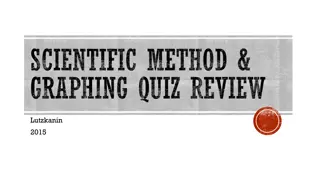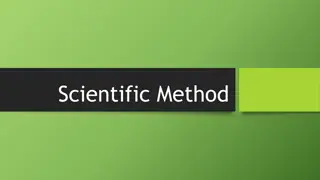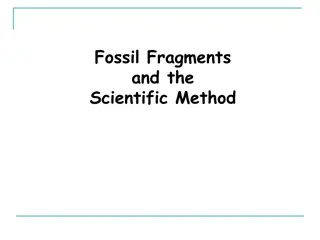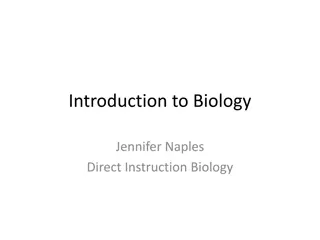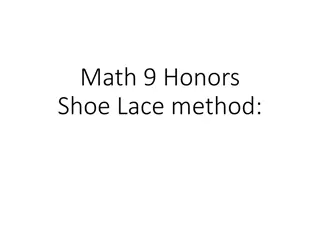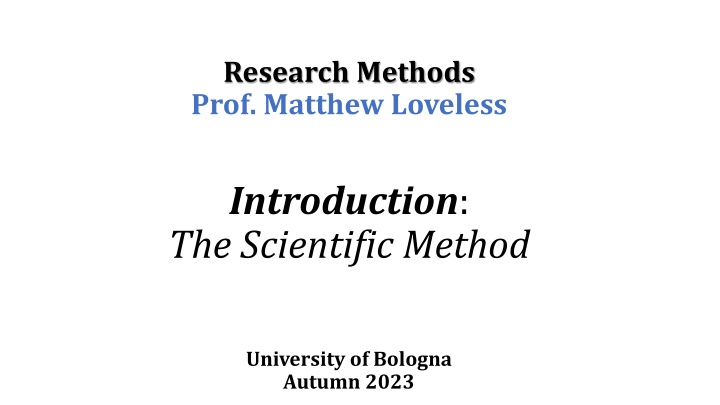
Research Methods with Prof. Matthew Loveless at University of Bologna
Join Professor Matthew Loveless for an in-depth exploration of research methods and the scientific method at the University of Bologna. Discover the importance of quantitative methodology, explore key concepts such as causality and hypothesis testing, and delve into statistical techniques for data analysis. Connect with Prof. Loveless for office hours and seminar schedules to enhance your learning experience.
Download Presentation

Please find below an Image/Link to download the presentation.
The content on the website is provided AS IS for your information and personal use only. It may not be sold, licensed, or shared on other websites without obtaining consent from the author. If you encounter any issues during the download, it is possible that the publisher has removed the file from their server.
You are allowed to download the files provided on this website for personal or commercial use, subject to the condition that they are used lawfully. All files are the property of their respective owners.
The content on the website is provided AS IS for your information and personal use only. It may not be sold, licensed, or shared on other websites without obtaining consent from the author.
E N D
Presentation Transcript
Research Methods Prof. Matthew Loveless Introduction: The Scientific Method University of Bologna Autumn 2023
Outline An Introduction Aims of the Course Scientific Method Questions?
Why Quantitative Methodology? Ugh. So what? One Reason: A lot of what we know about the world is discovered and often explained in the language of quantitative methods. e.g. Voting: A, B, & C and X, Y, & Z Voting e.g. Conflict: D, E, & F and R, S, & T Conflict Another Reason: Participation often higher participation - in a broader set of job sectors you will need a passing if not working knowledge of statistics . Why let other people explain the world to you?
Your Destiny Causality Chi-2 Classical Hypothesis Testing (Significance Testing) Conceptualization Confidence Intervals Controlled comparisons Correlation Cross Tabs Degrees of Freedom Dependent Variable Difference of Means Test (t- test) Dummy Variables First order correlation coefficients [or partials ] F-test Five Assumptions of Regression Gamma Generalization/ Inference Hypothesis Independent Variable Positive Relationships PRE statistics P-Value Adjusted-R2 Regression Coefficient Regression Equations Scatterplot Standard deviation Standard Error Standardized and unstandardized regression coefficients Statistical Inference Statistical Significance t-scores T-Test Theory Unit of Analysis Variable Variance Z distribution and z-scores Interval-level Variable Intervening Variable Lambda Level of Measurement Linear Regression Logistic Regression Measures of Association Measures of Central Tendency Measures of Dispersion Model Fit Model Specification Multicollinearity Multiple Regression Negative Relationships Nominal-level Variable Normal Distribution Null hypothesis Operationalization Ordinal level Variable Ordinary Least Squares Population vs. Sample
Contact Information Prof. Matthew Loveless Office: Via dei Bersaglieri 19 Office Hours: by appointment [Thursday 13-15] Email: paulmatthew.loveless@unibo.it Office Phone:
Marks and Assignments Lecture: Thursday, 11-13 Y Seminar: Friday 9-10 [Seminar Group 1]; 10-11 [Seminar Group 2] Electronic Support: Virutale - !Sign up on Virtuale! Marks: the final mark has 2 parts: 50% of the final grade is the mean of 9 weekly assignments (dropping the lowest). 50% of the final grade is a final exam covering material from all parts of the course. Required Text: Loveless, Matthew 2023. Political Analysis: A Guide to Data and Statistics. 1st edition. Sage.
Every hero needs a trusty sidekick Your university adventure is about to begin and we ve got your back! 30% OFF Get 30% discount and free P&P on all SAGE and Learning Matters books. 1. Go to sagepub.co.uk 2. Find and add your book(s) to the shopping basket Enter discount code UK23BOLOG at 3. checkout and press Apply We ve got your back.
Aims for the Course I Statistical Literacy Read, understand, and critically assess quantitative research Use the appropriate techniques QM abilities Ability to generate descriptive and inferential statistics using statistical software and interpret and analyze the output. Use statistical techniques to inform and/or support an argument and to recognize the limitations of statistical techniques Research skills Rigorously employ quantitative methodology to address a research question, present quantitative research in a clear, informative, and effective manner, and evaluate examples of quantitative research
Aims for the Course II For us, this course is an attempt to gain an understanding of how Quantitative Methods summarize and represent relationships among data and variables the theoretical underpinnings of Quantitative Methods What They Can And Cannot Do ( WTCACD ) Quantitative Methods ability to be used as a tool of the Scientific Method
Math Skills and Key Terms University Student Math Skills: 3 + 2 = 8 5 = 4 * 5 = 6>1.7= 5 3 20 true
Math Skills and Key Terms Empirical: Use of data to support analysis Qualitative (Empirical) Research: Use of data so that similar things are grouped and dissimilar things are separated by qualities or attributes Quantitative Research: Use of statistics, formal logic, or other computational solutions to analyse data Quantitative Methods ability to be used as a tool of the Scientific Method
Week 1 Topic: Course s Introduction and the Scientific Method The Scientific Method. The Use of Theory and Hypotheses;. Data and Variables: Conceptualization and Operationalization. Levels of Measurement. Readings: Chapters 1 - 4 in Political Analysis.
What is Science? It is a means to understand the world. At the core is the assumption that the world is ultimately knowable and that we can converge on that knowledge through the application of an agreed upon and rigorous methodology. The Scientific Method is an objective and replicable analysis of data which results in evidence which can be used to assess proposed explanations for a relationship and whether we can export the resultant explanation to other phenomena.
Why Science? The Scientific study of politics is crucial It offers analytical comparability and consistency as well as the ability to make cumulative progress in our understanding of political phenomena. It grows by the repeated overthrow of theories with the help of evidence in an attempt to de-code the (political) world Politics is worth knowing about The Big Game The Big Burning Questions
The Scientific Method Or what makes research scientific? 1. A transparent and replicable description of the research design and analysis 2. An attempt to identify and explain the relationship under investigation 3. The ability to make appropriate inferences from the results of the research
Principle Number 1 The scientific method requires a transparent and replicable description of the research design and analysis. The Scientific Method is not a tool. A scientific study provides an accurate, comprehensive, and objective description the analysis so that others can replicate the work. One reason is that the choice of tools can be very subjective and therefore lead to different conclusions.
Principle Number 1 Objectivity an attempt to eliminate or minimize the influence of our own prejudices, biases, etc A uniform, non-normative method of inquiry as a means to impose objectivity. Normative evaluative, value-laden, etc. How things should be? Non-normative Factual and objective. How things are? A.K.A.: positive approach e.g.: the study of political participation
Principle Number 1 The Challenge of Objectivity Politics is inherently value-laden. Politics is loaded. Political phenomena often represent an event and its significance. How neutrally can we investigate inequality, war, poverty, bias, class, corruption, ethnic conflict, gender disparity? The intensity, apathy, passion, enthusiasm, disdain, unexpectedness, division, joy, and madness of politics. And there are fiercely competing visions of what constitutes a better or worse way of doing things.
Principle Number 1 Because choices must be made, scientific study must be a public procedure. e.g.: peer-review The results of research are nearly secondary to how you arrived at them. Thus, the Scientific Method doesn t describe what we study, it describes how we study it.
Principle Number 2 The Scientific Method attempts to identify, isolate, and explain the relationship under investigation. Move from description to explanation ONE: The first means to identify and explain a relationship is the use of theory We seeks to identify a class of events that have applicability beyond the cases under investigation DESCRIPTION EXPLANATION PREDICTION
Principle Number 2 DESCRIPTION EX: Before the last Bundestag elections in Germany, we ask 1,000 Germans about their education and voting and determine that within this group, people with higher levels of education voted more often. Description: In this group of Germans in the past national election, the more highly educated voted more often than less educated ones. Explanation: It is easier for educated Germans to gather information about politics and therefore, I make the argument that they vote more because the costs of voting are lower for them. Prediction: What might be one of several predictive statements we could make? Scientific knowledge is explanatory and even predictive EXPLANATION PREDICTION
Principle Number 2 TWO: The second means to identify and explain a relationship, is through control. In order to evaluate the nature of the relationship in which we are interested, we must control for all other potential intervening or moderating influences. The signal versus the noise We are challenged not only to determine whether this relationship exists but also whether it continues to exist when we consider all of the other possible explanations
Principle Number 3 The Scientific Method seeks to derive and make proper inferences from the results of our research. Levels of Scientific Debates Epistemological the study of knowing Scientific method vs. post-modernism Methodological how we find out Quantitative vs. Qualitative Research technique use of theory and proper inference Idiographic vs. Nomothetic EX: What can we expect to learn from a case study of Benin s political institutional evolution and a seven country, cross-national study of sub- Saharan west Africa s political institutions?
Principle Number 3 Inference is not the same as prediction. Recall our educated German voters above. In the next Bundestag election, more educated Germans will vote at a higher rate than less educated Germans. OR in the upcoming Bundesrat election, more educated Germans will vote at a higher rate than less educated Germans. OR all European countries national parliamentary elections, more educated Europeans will vote at a higher rate than less educated European voters in that same country. (Causal) inference carries the explanation itself because it is easier for educated citizens to gather and process information about politics and are therefore more likely to vote because the costs of voting are lower for them.
Principle Number 3 Descriptive vs. Causal Inference Many phenomena have seemingly many correct answers Recall: Description Explanation Descriptive Inference: Discrete expectations about an unstudied group by observation of a selected group EX: the German example of education and voting We were trying to export from what we could describe about one group to speak to a new group or event Causal Inference: Inferring causality from observation. Not only <above> but we are also imposing our explanation on them Prediction
Principle Number 3 One of the elements of the scientific research methodology is the ability to be confident about our findings Probabilistic: random variation exists in the world and there is nothing you can do about it. Deterministic: given the right explanatory variables, the world is entirely predictable It is important to understand the difference between a statement of certaintyand a statement that we have a great deal of confidence in. Water Boiling vs. Education Voting
Statistics: The Illustrious Triumvirate Description: Statistics summarizes the nature of variables and relationships. It also takes uncertainty seriously by determining how certain (or uncertain) we can be in our results. Inference: We can make claims about broader processes than merely the ones in our sample. Control: Statistics can isolate and assess the relationship in which we are interested, closely resembling the standard of experimental control.
Doing Statistics is not doing Science The Scientific Method A transparent and replicable description of the research design and analysis. Statistics Principle Number 1 Statistics has an internal formal rigor grounded in the use of mathematics as its language which eases the handling of assumptions and estimating results. As such, statistics techniques follow a formal methodology specifically to enable replicability. Statistics exposes patterns. It summarizes data, variables, and relationships between variables. Crucially, outside the laboratory, statistics is the most effective method for exerting control large arrays of competing explanations in scientific studies. Statistics has an explicit use for and reporting of variance which, in its most advanced form, is a measure (un)certainty. Using this, we have the ability to make qualified inferences about unobserved phenomena. Principle Number 2 To identify, isolate, and explain the relationship under investigation. Principle Number 3 Steps to assess the appropriate inferences from the results.
Quantitative Methodology Where does QM fit in the Scientific Method? Data Information Knowledge Analysis turns data into information QM is the analytical treatment of data QM does not replace our ability to ask better questions or to think critically or creatively about a problem. SM is one way to turn information into knowledge. QM cannot make this step.
Conclusion: Scientific Method Scientific Method is a methodology to accumulate (and discard) information in order to understand an observable and ultimately knowable world. Quantitative Methods [Statistics] is a tool, a set of mathematical manipulations, that allow us to summarize and assess relationships. We seek probabilistic, general knowledge about political and social phenomena. How is this achieved? Answer: Theory and Hypotheses
Theory in the Social Sciences Definition: A systematically related set of propositions that provide possible explanations for a set of phenomena. Theory s Role in Social Science ONE: Identifies relationships about the phenomenon that we are interested in. TWO: Summarizes work that has been done on our subject. THREE: Suggests where to look for future testing.
Theory in the Social Sciences Theories are necessarily simplified models of reality All models are wrong, but some models are useful All models are simplifications of the universe as they must necessarily be. e.g.: Models of planes, trains, or automobiles Theories are not right or wrong. They are weak or strong.
Inductive and Deductive Reasoning Induction: Specific to general Observation Theory Deduction: General to specific Theory Observation EX: The Agenda Setting theory states that the issues that are most prominent in the news are also the issues that are most important in public opinion.
A Model of the Role of Theory Model (Theory) Deduction Potential Data Induction World Observed Data
Theory in the Social Sciences Theories are not Right or Wrong. They are Weak or Strong Strong theories continue to generate and explain, accumulating evidence as support Weak ones fail to do so.
Core Characteristics of Theory I ONE: A strong theory is a plausible explanation for the relationship in which we are interested. (1) Does it make sense? Is it logically sound and internally coherent? EX: Height and Presidents Vary
Core Characteristics of Theory I ONE: A strong theory is a plausible explanation for the relationship in which we are interested. (2) Does it correspond with reality? Are the variables measurable (i.e.: have observable empirical referents) EX: je ne sais quoi Not uncommon: many of the concepts in which we are interested resist easy empirical capture; e.g.: power, trust, legitimacy, representation, social capital, party identification, inequality, negative media coverage, or sovereignty A perfectly enlightened community will produce the philosopher king
Core Characteristics of Theory II TWO: A strong theory is fertile. It does a good job of explaining what we are interested in and keeps on explaining. Why is globalization occurring? Why do countries try to become democracies? Why do people distrust the EU? Generate as many observable implications as possible
Core Characteristics of Theory III THREE: A theory should be parsimonious. The ability for a theory to explain as much as it can with as little as possible. Perhaps we can think of this as efficiency or leverage as in we want to leverage greater explanatory power with a relatively simple explanation. Theory as a model: we need all of the necessary parts. This is theory s heuristic function the efficient use of knowledge
Criteria for Evaluating Theory FOUR: Falsification: A strong theory must have defined parameters that tell us when they will not work. Theories are not Right or Wrong. They are Weak or Strong All theories are simplifications of reality and thus always wrong. But .
Causation and Theory Theory is an inherently causal argument Why something had to happen David Hume & John Stuart Mill Contiguity between cause and effect X and Y covary Temporal precedence A change in X precedes a change in Y Constant conjunction (when Y changes, X is there) a.k.a.: non-spuriousness
Causation in the Social Sciences Theory is an inherently causal argument Why is causality so important? Simultaneously, causal thinking belongs completely on the theoretical level although supported empirically This means that it is helpful to think causallyand to develop models that have causal implications (even if only indirectly testable). To be clear (again): Causality or causal laws are working assumptions or tools of the scientist rather than verifiable statements about reality.
Causation in the Social Sciences Causality as a working component of theoretical thinking Causation and the Problem of Measurement e.g. Inequality and Democracy Universal Causal Mechanisms How universal is causality? What are the limits? e.g.: CEE Mass Media Causation as a Limit on Discovery Demonstrate causality where we can, avoiding the messier topics Not only where Y will be [prediction] but why it will be there [explanation].
For Emphasis and Clarity: Causation and Theory Theory
Conclusion Therefore, a theory s validity is determined through observation tested against competing theories which over time - make an explanation more probable or more correct than others. IOW, which ones are more more likely Theories are incomplete but useful How do we test theories? We need real world implications Hypotheses and data and variables

